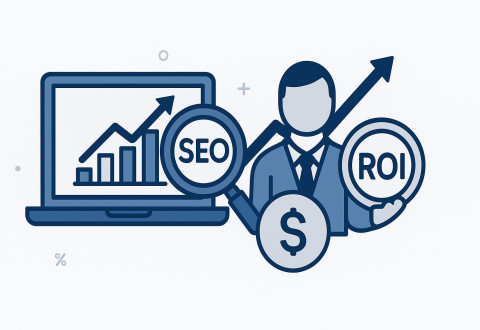After working with hundreds of businesses to implement SEO measurement frameworks, I’ve seen firsthand how proper ROI tracking transforms companies’ perception of search marketing. Most businesses dramatically undervalue SEO because they lack the systems to measure its true impact.
When you implement the measurement strategies I’ll share in this guide, you’ll not only justify your SEO investments but often discover that search engine optimization delivers far higher returns than any other marketing channel. The frameworks I’ve developed have helped enterprise clients demonstrate SEO value that led to budget increases of 200-400%.
❗ SEO delivers an average ROI of 748% with some industries seeing returns over 1,300%
❗ 72% of marketers report that organic search provides the highest returns among all marketing channels
❗ SEO leads convert at 14.6%, which is 8.5 times higher than outbound marketing leads
❗ Most businesses see positive ROI within 6-12 months, with peak results emerging at 2-3 years
❗ The average SEO ROI ratio is 22:1, meaning every $1 invested returns $22
Understanding SEO ROI Fundamentals
SEO return on investment measures the business value generated from search engine optimization activities compared to the costs invested. Unlike traditional marketing channels with immediate, trackable results, SEO ROI requires understanding long-term value creation and multi-touch attribution models.
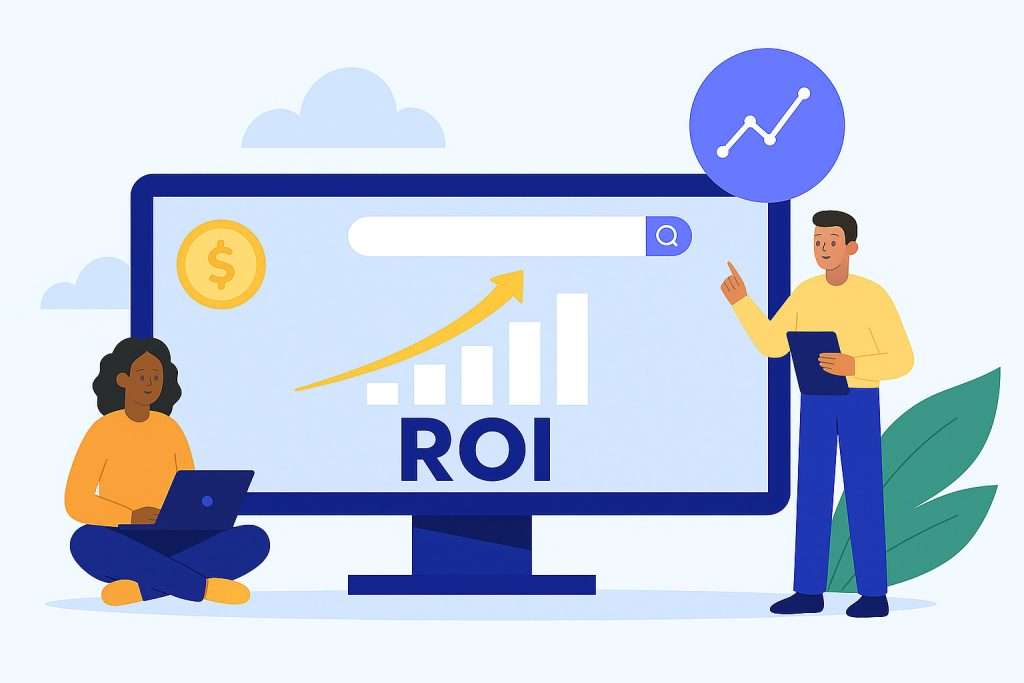
What makes SEO unique is its compounding nature. While paid advertising stops generating results the moment you stop spending, SEO creates lasting value through improved organic visibility. The average conversion rate for SEO is 2.4%, with positive ROI typically achieved within 6 to 12 months.
The most successful companies I work with view SEO as a strategic investment rather than a marketing expense. They understand that organic search accounts for 53% of all trackable web traffic, making it the foundation of sustainable digital growth.
Key Components of SEO ROI:
- Investment costs (tools, content, personnel, technical implementation)
- Revenue attribution from organic search traffic
- Time considerations for long-term value assessment
- Multi-channel attribution models
- Brand value and competitive positioning benefits
SEO vs. Other Marketing Channels:
- SEO average ROI: 22:1 (2,200%)
- PPC average ROAS: 2:1 (200%)
- Email marketing average ROI: 36:1 (3,600%)
- Social media marketing ROI: 2.5:1 (250%)
Why Traditional ROI Metrics Fall Short for SEO
Traditional marketing ROI models assume direct, immediate attribution between investment and return. SEO challenges this model because its value creation spans multiple touchpoints across extended timeframes.
The attribution challenge becomes complex when prospects engage with your content through organic search multiple times before converting. I’ve observed customer journeys where initial SEO contact occurs 6-18 months before final conversion, making traditional last-click attribution models inadequate.
Common Attribution Limitations:
- Multi-touch customer journeys spanning months
- Brand awareness impacts difficult to quantify
- Competitive displacement effects
- Long-term compound value creation
- Cross-channel influence and support
Expert Insight: Most businesses using last-click attribution models undervalue SEO by 40-60% because they miss the full customer journey impact.
How to Calculate SEO ROI
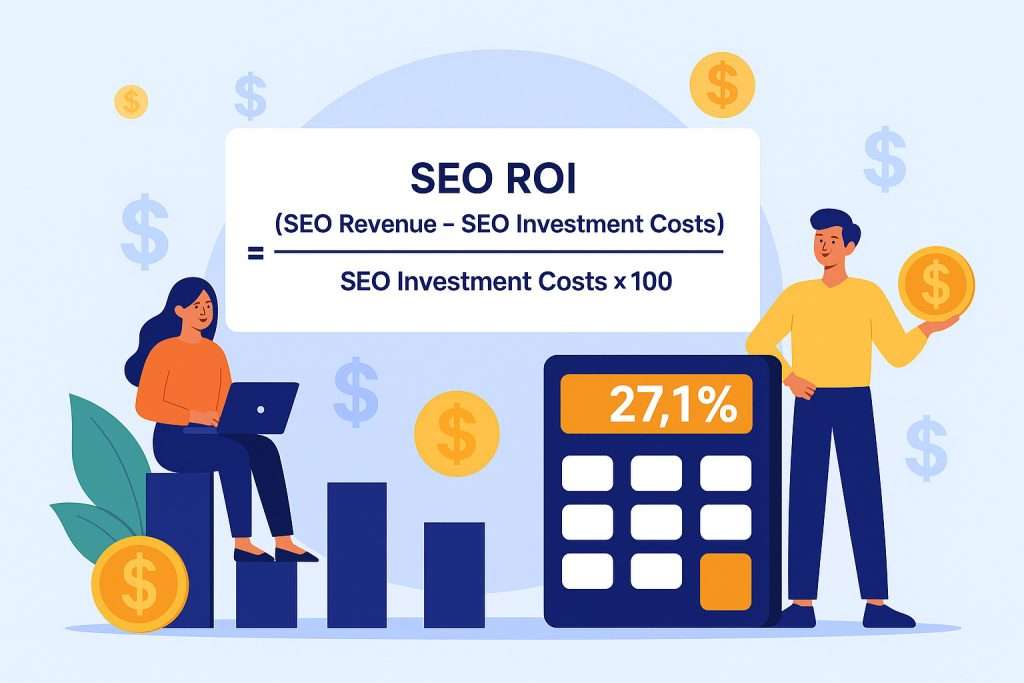
The fundamental SEO ROI formula provides the foundation for all measurement approaches:
SEO ROI = (SEO Revenue – SEO Investment Costs) ÷ SEO Investment Costs × 100
This calculation requires precise tracking of both investment costs and attributable revenue. Based on my experience implementing measurement systems, accuracy depends on comprehensive cost tracking and sophisticated attribution modeling.
Let me walk you through a real-world example. A client invested $48,000 over six months in content creation (48 blog posts) and generated $61,000 in attributed revenue:
ROI Calculation:
- SEO Revenue: $61,000
- SEO Investment: $48,000
- Net Profit: $13,000
- ROI: ($13,000 ÷ $48,000) × 100 = 27.1%
This means every $100 invested in SEO returned $127, representing strong performance for a six-month campaign.
Establishing Your SEO Investment Costs
Accurate cost tracking forms the foundation of reliable ROI measurement. Through my audits, I’ve identified that most businesses underestimate their true SEO costs by 30-50%, leading to inflated ROI calculations.
Comprehensive SEO Cost Categories:
Personnel Costs:
- In-house SEO team salaries and benefits
- Content creators and copywriters
- Web developers for technical implementation
- Project management and oversight
Tool and Technology Costs:
- SEO software subscriptions (analytics, keyword research, ranking tools)
- Content management systems and plugins
- Technical SEO tools and monitoring services
- Reporting and dashboard platforms
Content and Asset Creation:
- Blog post creation and editing
- Video and multimedia production
- Graphic design and visual assets
- Professional photography and imagery
Technical Implementation:
- Website optimization and development
- Server and hosting upgrades
- CDN and performance optimization services
- Security and SSL certificate costs
External Services:
- SEO agency or consultant fees
- Link building and outreach services
- Technical audits and specialized services
- Training and professional development
Determining SEO Revenue and Returns
Revenue attribution represents the most challenging aspect of SEO ROI measurement. I’ve developed attribution models that account for the multi-touch nature of SEO while providing actionable insights for optimization.
Primary Attribution Methods:
Direct Revenue Attribution: Track conversions where organic search was the final touchpoint before purchase. Use Google Analytics’ attribution reports to identify SEO-driven sales with specific campaign and keyword data.

Assisted Conversion Value: Measure SEO’s role in multi-channel customer journeys. Google Analytics shows how organic search assists conversions that ultimately convert through other channels.
Branded vs. Non-Branded Value: Separate revenue from branded searches (people looking for your company) from non-branded searches (people discovering you through general terms). Non-branded revenue represents true new customer acquisition.
Customer Lifetime Value Integration: Calculate the long-term value of customers acquired through SEO. Since SEO typically attracts higher-quality leads, their lifetime value often exceeds other channels by 20-40%.
5 Proven Methods to Measure SEO ROI
Based on my work with diverse business models, I’ve developed five distinct measurement approaches. Each method suits different business contexts, data availability, and stakeholder requirements.
The key to successful ROI measurement lies in selecting the appropriate method for your specific situation. I use a decision framework that considers business model, available data, conversion tracking capabilities, and reporting requirements.
Method 1: Conversion Tracking for E-commerce
E-commerce businesses have the advantage of direct revenue attribution through transaction tracking. This method provides the most accurate ROI measurements when properly implemented.
Implementation Steps:
1. Configure Enhanced E-commerce Tracking Set up Google Analytics Enhanced E-commerce to track product purchases, revenue, and transaction details from organic search traffic.
2. Implement UTM Parameters Use consistent UTM tagging for SEO campaigns to isolate organic performance from other traffic sources.
3. Set Up Goal Funnels Create conversion funnels that track the complete customer journey from search to purchase.
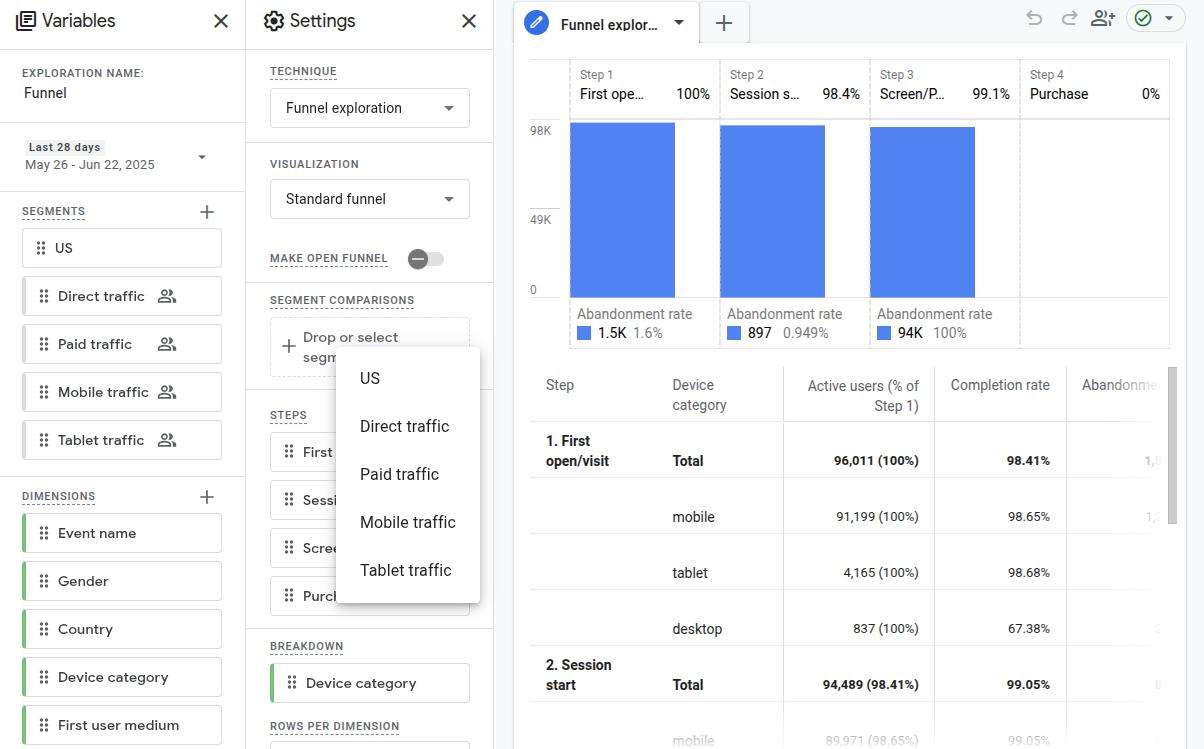
4. Attribution Model Selection Choose attribution models that reflect your customer journey patterns, typically time-decay or data-driven attribution.
5. Revenue Segmentation Separate revenue by product categories, customer segments, and keyword themes to identify highest-value SEO opportunities.
Key Metrics for E-commerce ROI:
- Organic transaction revenue
- Average order value from organic traffic
- Conversion rate by landing page
- Customer acquisition cost through SEO
- Revenue per organic session
Method 2: Lead Value Attribution for B2B
B2B businesses require lead scoring and customer lifetime value calculations to measure SEO ROI accurately. This method focuses on lead quality and long-term value creation.
Lead Scoring Framework:
Qualification Criteria:
- Company size and industry fit
- Decision-maker engagement level
- Content consumption patterns
- Contact information completeness
- Sales-qualified lead progression
Value Assignment Process:
- Calculate historical close rates for leads by source
- Determine average deal size for SEO-generated opportunities
- Factor in sales cycle length and probability
- Apply customer lifetime value multipliers
- Account for referral and expansion potential
Implementation Process:
- Integrate CRM tracking with Google Analytics
- Set up lead scoring automation
- Create attribution reports linking SEO activities to closed deals
- Develop dashboards showing lead-to-customer progression
- Track long-term account value and expansion
Method 3: Competitive Displacement Value
This method quantifies SEO value through market share capture and competitive positioning improvements. It’s particularly valuable for businesses in competitive markets where SERP real estate directly impacts market share.
Market Share Calculation: Estimate the total search volume for your industry keywords and calculate your visibility share. Improvements in visibility share represent direct competitive displacement.
SERP Position Value Curve: Research shows exponential value increases with higher rankings:
- Position #1: 35-40% of clicks
- Position #2: 15-20% of clicks
- Position #3: 10-12% of clicks
- Positions #4-10: Diminishing returns curve

Implementation Framework:
- Keyword Universe Mapping Identify all relevant keywords in your market with search volumes and competitive data.
- Visibility Tracking Monitor your share of voice across keyword groups and compare to competitors.
- Value Assignment Calculate potential revenue for each ranking position based on click-through rates and conversion data.
- Competitive Intelligence Track competitor ranking changes and estimate market share shifts.
Method 4: Cost Avoidance Comparison
This method calculates SEO ROI by comparing organic traffic value to equivalent paid search costs. It’s particularly effective for demonstrating SEO value to stakeholders familiar with PPC metrics.
Calculation Process:
Step 1: Keyword Value Analysis
- Export organic keyword rankings and traffic data
- Research Google Ads CPC for each ranking keyword
- Calculate total monthly paid search cost equivalent
Step 2: Traffic Quality Adjustment
- Factor in conversion rate differences between organic and paid traffic
- Adjust for brand vs. non-brand keyword values
- Account for click-through rate differences
Step 3: Ongoing Cost Comparison
- Calculate monthly “avoided” PPC costs through organic rankings
- Factor in the sustainability advantage of organic vs. paid visibility
- Include competitive advantage of occupying both organic and paid SERP space
Example Calculation:
- Monthly organic traffic: 10,000 visitors
- Average CPC equivalent: $2.50
- Monthly avoided PPC cost: $25,000
- Annual avoided cost: $300,000
- SEO investment: $100,000
- Cost avoidance ROI: 200%
Method 5: Brand Value and Authority Metrics
This method quantifies the non-direct revenue benefits of SEO, including brand awareness, thought leadership, and market authority development.
Brand Value Measurement Framework:
Brand Search Volume Growth: Track increases in branded search terms and related queries. Growing brand search volume indicates successful awareness building through SEO content.
Share of Voice Expansion: Monitor your content’s visibility across industry-related searches. Increased share of voice in non-branded terms builds thought leadership and market authority.
Earned Media Value: Calculate the equivalent advertising value of SERP visibility and content engagement. This includes featured snippet appearances, knowledge panel presence, and top rankings for industry terms.
Trust and Authority Indicators:
- Backlink quality and quantity growth
- Domain authority improvements
- Social media engagement with SEO content
- Industry recognition and citations
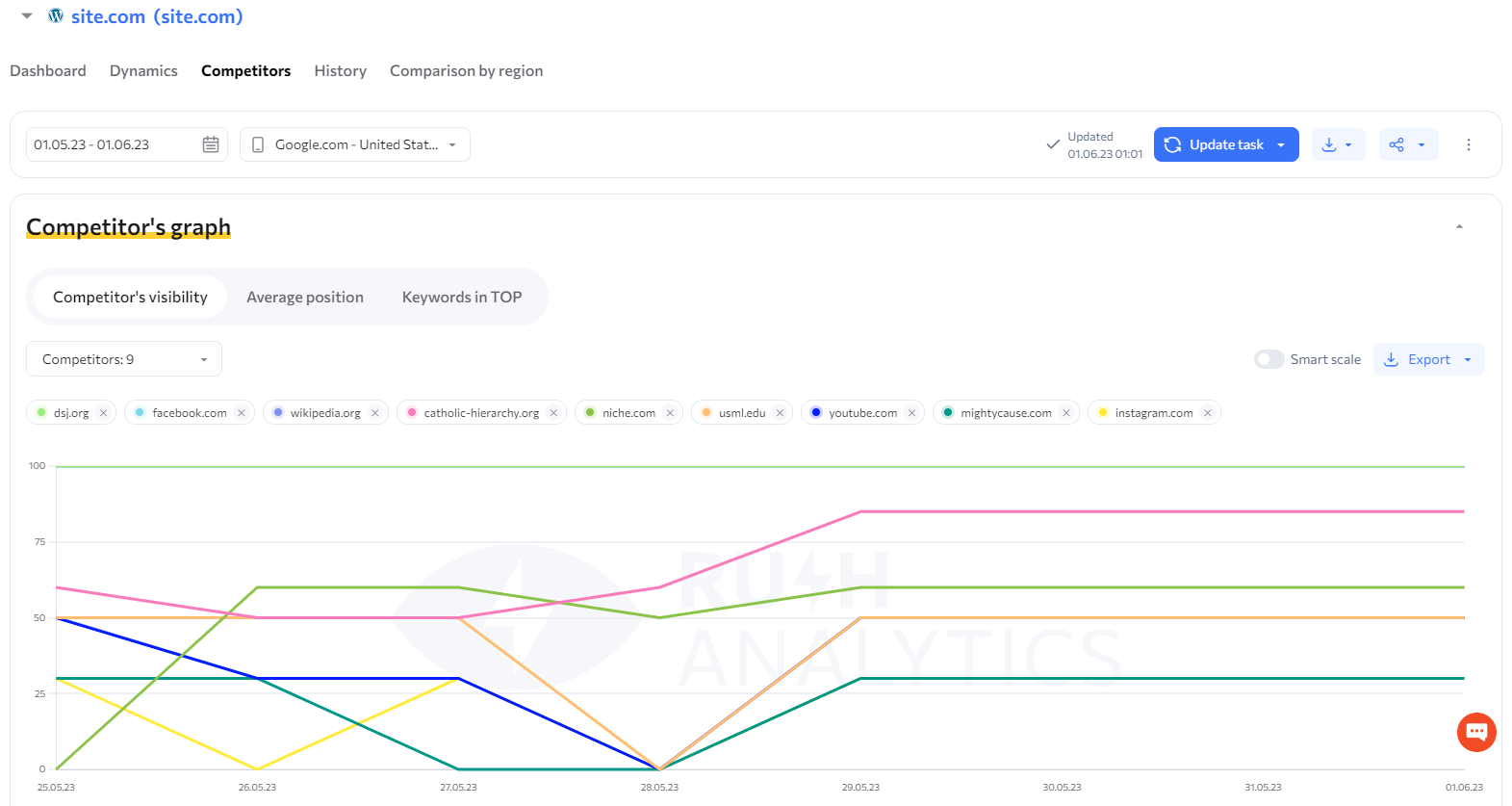
Quantification Methods:
- Media Equivalent Value: Calculate advertising cost equivalent for SERP visibility
- Brand Lift Studies: Measure awareness changes in target markets
- Customer Survey Data: Track brand recognition and consideration metrics
- Referral Traffic Growth: Monitor increases in direct and referral traffic indicating brand strength
Free 7 days access to all tools. No credit card required!
Попробовать бесплатно
Forecasting Future SEO ROI
Accurate ROI forecasting enables better investment planning and expectation setting. My forecasting methodology combines historical performance data with market opportunity analysis to project future returns.
Forecasting Variables:
Content Performance Trajectory: New content typically follows predictable performance curves. Blog posts reach peak traffic 12-18 months after publication, while evergreen pages continue growing for 2-3 years.
Competitive Landscape Changes: Monitor competitor SEO investments and market share shifts. New competitors entering the market can impact your growth trajectory, while competitor exits create opportunity acceleration.
Algorithm and Market Evolution: Factor in expected algorithm updates, SERP feature changes, and market maturity evolution. Emerging markets show higher growth potential than saturated categories.
Investment Scale Impact: SEO returns typically follow logarithmic curves. Initial investments show higher percentage returns, while scaling requires proportionally larger investments for incremental gains.
Forecasting Model Components:
1. Baseline Performance Analysis
- Current organic traffic and conversion trends
- Content performance decay and growth curves
- Seasonal variation patterns and cyclical impacts
2. Market Opportunity Assessment
- Available keyword search volumes and competition levels
- Market share analysis and competitor gap identification
- Emerging trend and topic opportunity evaluation
3. Investment Impact Modeling
- Content production capacity and publishing velocity
- Technical optimization implementation timeline
- Link building and authority development progression
4. Scenario Planning
- Conservative, expected, and optimistic performance scenarios
- Risk factor assessment and mitigation strategies
- Competitive response and market change implications
Common SEO ROI Pitfalls and How I Avoid Them
Through hundreds of SEO audits, I’ve identified recurring measurement errors that lead to inaccurate ROI calculations. Understanding these pitfalls helps ensure reliable measurement and realistic expectation setting.
Top 5 SEO ROI Pitfalls:
- Traffic-Only Focus: Measuring success purely through traffic metrics without conversion tracking
- Attribution Window Errors: Using inappropriate timeframes for measuring SEO impact
- Cost Underestimation: Missing hidden costs that inflate apparent ROI
- Competitive Context Ignorance: Failing to account for market changes and competitive responses
- Short-Term Measurement: Evaluating SEO ROI before sufficient time for impact development
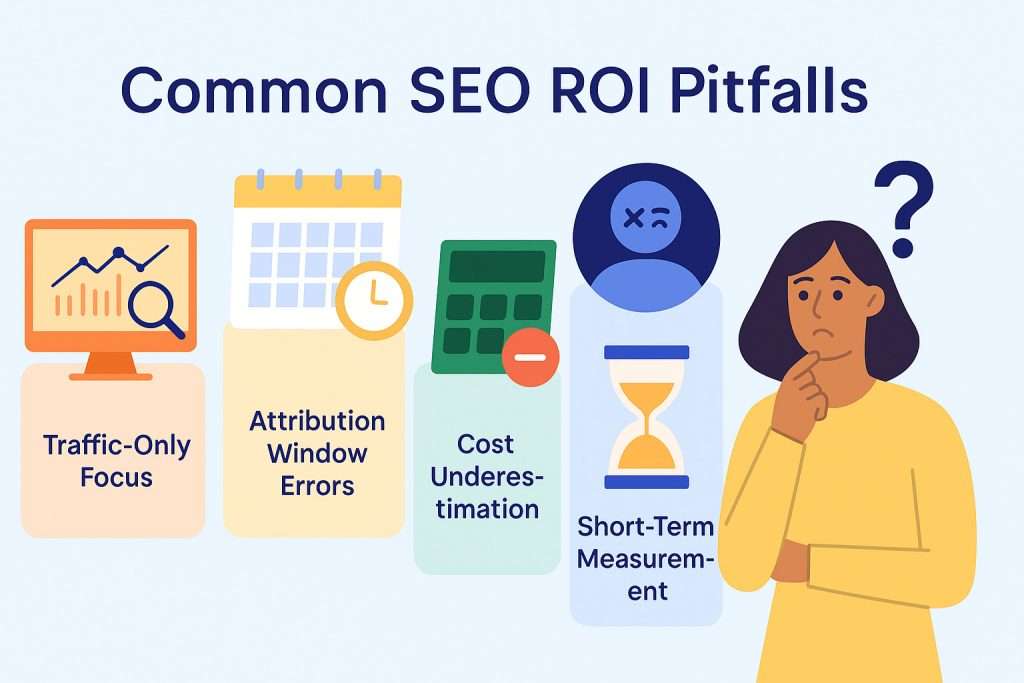
Avoiding the Traffic-Only Trap
Traffic metrics provide important indicators but fail to capture business value. Many businesses celebrate traffic growth while missing conversion optimization opportunities that would dramatically improve actual ROI.
Beyond Traffic Measurement:
Quality Metrics Focus:
- Conversion rate by traffic source and landing page
- Average session duration and page depth
- Bounce rate analysis and engagement indicators
- Goal completion and micro-conversion tracking
Business Impact Connection:
- Revenue attribution and customer acquisition costs
- Lead quality scores and sales progression rates
- Customer lifetime value and retention metrics
- Market share and competitive positioning improvements
Implementation Strategy: Replace traffic-focused reporting with business-impact dashboards. Show stakeholders how traffic quality improvements translate to revenue growth, even when total traffic remains stable.
Solving the Attribution Window Problem
SEO impact unfolds over extended timeframes, making attribution window selection critical for accurate measurement. Too short windows undervalue SEO, while excessive windows include unrelated factors.
Attribution Window Guidelines:
- Content Marketing SEO: 6-18 months for blog content to reach full potential
- Technical SEO: 3-6 months for crawling and indexing improvements
- Link Building: 4-12 months for authority transfer and ranking impact
- Local SEO: 2-6 months for local pack visibility improvements
Multi-Window Analysis: Track SEO performance across multiple timeframes simultaneously. This approach reveals both immediate wins and long-term value creation, providing complete ROI visibility.
Implementation Framework:
- Immediate Impact Tracking (0-3 months): Technical fixes and quick wins
- Medium-Term Assessment (3-12 months): Content performance and ranking improvements
- Long-Term Value Analysis (12+ months): Brand building and market share growth
- Lifecycle ROI Calculation: Complete campaign value from launch to maturity
Conclusion: Implementing Your SEO ROI Measurement Framework
Proper SEO ROI measurement transforms how businesses view and invest in search engine optimization. The frameworks I’ve shared have helped clients demonstrate SEO value that justified budget increases averaging 250% within the first year of implementation.
The key to success lies in selecting measurement methods that align with your business model, available data, and stakeholder requirements. Start with the simplest applicable method and gradually sophisticate your approach as you build measurement capabilities.
Immediate Action Steps:
- Audit Current Tracking: Identify gaps in your existing SEO measurement and attribution setup
- Select Primary Method: Choose the ROI measurement approach that best fits your business model
- Implement Tracking Infrastructure: Set up analytics, attribution models, and reporting systems
- Establish Baseline Metrics: Document current performance to measure future improvements against
- Create Reporting Cadence: Develop regular ROI reporting that demonstrates SEO value to stakeholders
Remember that SEO ROI measurement is as much about organizational education as technical implementation. 70% of marketers confirm that SEO generates more sales than PPC, yet many businesses continue underinvesting in organic search due to measurement challenges.
When you implement these measurement frameworks, you’ll not only prove SEO’s value but often discover it’s your highest-performing marketing channel. The businesses that succeed with SEO are those that measure it properly and invest accordingly.
Expert Insight: The most successful SEO programs I’ve worked with share one common trait – they measure business impact, not just search metrics. When you connect SEO activities to revenue outcomes, budget conversations become investment discussions, and SEO transforms from a cost center to a growth driver.
FAQs
What is the ROI of SEO?
SEO ROI measures the business value generated from search engine optimization investments compared to costs. The average SEO ROI is 22:1, meaning businesses typically see $22 in returns for every $1 invested. However, ROI varies significantly by industry, with real estate achieving 1,389% returns and B2B SaaS companies averaging 702% ROI over three-year periods.What is the average ROI for SEO?
According to recent industry data, high-quality SEO campaigns achieve an average ROI of 748%. Most businesses see positive ROI within 6-12 months, with peak results typically emerging after 2-3 years. The average conversion rate for SEO is 2.4%, significantly higher than traditional marketing methods at 1.7%.What is the best ROI for SEO?
The highest SEO ROI is found in industries with high customer lifetime values and strong search demand. Real estate leads with 1,389% ROI, followed by medical devices at 1,183% and financial services at 1,031%. B2B companies generally achieve better ROI than B2C businesses due to higher transaction values and longer customer relationships.


